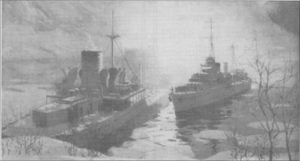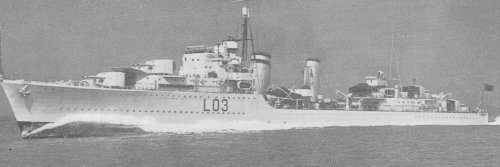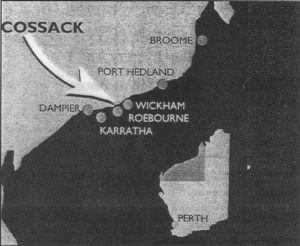- Author
- Stevens, Errol
- Subjects
- History - general, Ship histories and stories, WWII operations
- Tags
-
- RAN Ships
- None noted.
- Publication
- June 2001 edition of the Naval Historical Review (all rights reserved)

The name COSSACK, to many people, means a fierce sabre-wielding horseman from southern Russia. To most World War II naval veterans it reminds them of the exploits of the Tribal Class destroyer HMS Cossack.
With the cry of “The Navy’s here!” Captain Vian put Cossack alongside the German supply ship Altmark in the Norwegian Jossing fjord on the night of 16 February 1940. The boarding party rescued 303 personnel from Allied merchant ships sunk by the German pocket battleship Admiral Graf Spee. Norway was neutral at that time and the Germans had denied there were any prisoners on board.

Cossack went on to take part in many subsequent actions including Narvik, torpedo attacks on the Bismark, Russian and Malta convoys, until finally torpedoed by U563 on 22 October 41 in the Western Mediterranean. She lost her bow, foremast and most of the bridge area and the salvage attempt was unsuccessful with her after section sinking on 27 October 1941 in rough weather whilst in tow for Gibraltar.

To others, Cossack means a small town and port being restored on the Western Australian coast between Campier and Port Hedland. The origin of this name also has strong naval connections.
About 1861 to 1863 the first settlers in NW Western Australia landed at the mouth of the Harding River and in 1866 the first town in the area was declared as Roebourne some 13km inland. The port area was known unofficially as “Tien Tsin Harbour” after the name of the vessel which carried the settlers. Roebourne became the Administrative centre for the NW and the port prospered from the blossoming pastoral and mining industries around Roebourne and the influx of pearling luggers.
In 1871 WA Governor Weld visited in HM Screw Corvette Cossack (Captain Douglas), and in 1872 the port was officially declared as Cossack. This HMS Cossack had an interesting history. She had just finished building in U.K. for Russia as the Witjas when the Crimean War broke out. She was seized for the RN and renamed Cossack. She saw active service in that war against the Russians and subsequently served on the Australia Station from 1871 to 1873. She displaced about 2,000 tonnes, her length was 60 metres, beam 12 metres, draught 2.8 metres, and carried sixteen 64 pounder rifled muzzle-loading guns, and had both sails and a single screw.
The port of Cossack in its heyday had a population of about 1,500 but several severe cyclones in the 1880s and 1890s caused much damage and silting of the harbour. The luggers moved to Broome, and Point Samson, which could handle larger vessels from its jetty, took over. In 1910 the Municipality of Cossack was dissolved and in the 1950s it was abandoned. In 1979 restoration work on the old buildings such as the Court House, Post and Telegraph Office, Customs House and warehouses commenced. To anyone passing through the area a visit to Cossack is recommended.
The assistance of the Cossack Historic Town Restoration Committee is gratefully acknowledged.




